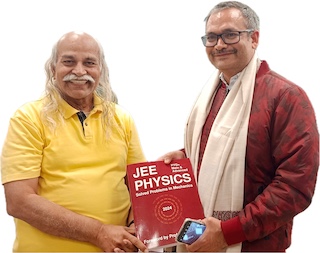Excess Pressure in Drops and Bubbles
The excess pressure in an air drop (or cavity) of radius $r$ due to the surface tension $T$ is given by \begin{align} \Delta p_\text{air}=\frac{2T}{r}. \end{align} A soap bubble has two surfaces. The excess pressure in a soap bubble is given by \begin{align} \Delta p_\text{soap}=\frac{4T}{r}. \end{align} The excess pressure is directly proportional to the surface tension and inversely proportional to the radius.
Problems from IIT JEE
Problem (IIT JEE 2008): A glass tube of uniform internal radius $r$ has a valve separating the two identical ends. Initially, the valve is in a tightly closed position. End 1 has a hemispherical soap bubble of radius $r$. End 2 has sub-hemispherical soap bubble as shown in the figure. Just after opening the valve,
- air from end 1 flows towards end 2. No change in the volume of the soap bubbles.
- air from end 1 flows towards end 2. Volume of the soap bubble at end $1$ decreases.
- no change occurs. air from end $2$ flows towards end $1$. Volume of the soap bubble at end $1$ increases.
Solution: The excess pressure inside a soap bubble of radius $r$ and surface tension $T$ is given by \begin{align} \Delta p=P-P_0=4T/r.\nonumber \end{align} Thus, the pressures inside the end 1 and end 2 of the tube are \begin{align} P_1&=P_0+4T/r_1, \\ P_2&=P_0+4T/r_2. \end{align} The radius $r_2$ of the sub-hemispherical bubble is more than the radius $r_1$ of the hemispherical bubble i.e., $r_2 > r_1$. Hence, from above equations, $P_1 > P_2$ and air moves from end 1 to end 2. As air moves out from end 1, the volume of soap bubble at this end decreases.
Problem (IIT JEE 2009): Two soap bubbles A and B are kept in a closed chamber where the air is maintained at pressure 8 N/m2. The radii of bubbles A and B are 2 cm and 4 cm, respectively. Surface tension of the soap-water used to make bubbles is 0.04 N/m. Find the ratio $n_B/n_A$, where $n_A$ and $n_B$ are the number of moles of air in bubbles A and B, respectively. (Neglect the effect of gravity.)
Solution: Let $r_A=2$ cm be the radius of the bubble A, $r_B=4$ cm be the radius of the bubble B, $P_0=8$ N/m2 be the chamber pressure and $T=0.04$ N/m be the surface tension. Let $P_A$ and $P_B$ be the pressure inside the bubble A and bubble B, respectively. The volumes of the two bubbles are \begin{align} V_A&=\tfrac{4}{3}\pi r_A^3, \nonumber\\ V_B&=\tfrac{4}{3}\pi r_B^3. \nonumber \end{align} The excess pressure inside a soap bubble of radius $r$ is given by $4T/r$. Thus, \begin{align} P_A&=P_0+4T/r_A, \nonumber\\ P_B&=P_0+4T/r_B. \nonumber \end{align} Since the temperatures of bubble A and bubble B are equal, the ideal gas equation for the air inside the soap bubbles gives \begin{align} P_AV_A/n_A=P_BV_B/n_B. \nonumber \end{align} Substitute $P_A$, $V_A$, $P_B$, and $V_B$ to get \begin{align} \frac{n_B}{n_A}&=\frac{\left(P_0+4T/r_B\right)r_B^3}{\left(P_0+4T/r_A\right)r_A^3}\nonumber\\ &=\frac{\left(8+4(0.04)/0.04\right)(0.04)^3}{\left(8+4(0.04)/0.02\right)(0.02)^3} \\ =6.\nonumber \end{align}
